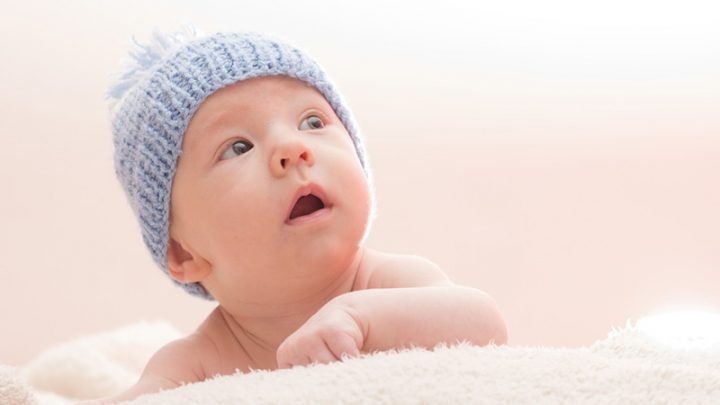When do babies say mama and dada? Why is your baby choking on milk? Why do babies stare?
These are some of the most common questions asked by parents (including non-parents) and today we’ll solve the mystery of that last question.
Have you ever noticed a baby staring at moving objects, like a ceiling fan, yourself or other familiar faces? Silly me. You probably noticed that a baby’s eyes are truly magnificent.
They absorb everything like a sponge, and sometimes they can’t help staring at you or other objects for a long time, and I mean a REALLY long time. This is when you ask yourself: Why do babies stare?
Here’s a scientific answer to your question:
Babies stare at people and inanimate objects because it helps them make sense of the world. They crave sensory experiences because that’s how their developing brains learn about the things and people around them.
To put it simply: Babies learn by observing!
To help you understand this better, I’ll explain the reasons why babies stare and when you should begin to worry about your baby’s staring habit. We’ll also go through some interesting facts about how vision works with baby’s, so be sure to read on!
Why Do Babies Stare?
1. They are mesmerized by moving objects
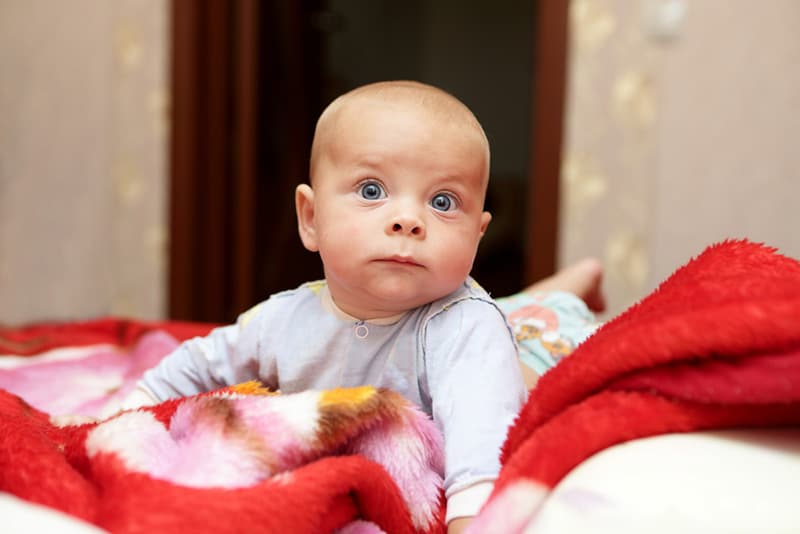
If you’re a feline fan, you probably know that cats are mesmerized by moving objects and will happily stare at them for hours without getting bored.
Now, I have no idea why cats do this, but I know why babies do it.
You’ve probably noticed your baby staring at ceiling fans, right? If you’ve googled it, you might have come across some experts, as well as self-proclaimed experts, claiming that this is connected with autism.
Seriously? Does it make any sense to diagnose your child just because he or she is mesmerized by moving objects? Of course not, because ALL babies do it.
Also, it is neither possible nor rational to diagnose any child who is under the age of 2 with autism, because their brains are still developing. In other words, they are still in the process of physical and mental development.
So, the main reason why babies stare at moving objects is that they find them interesting and sensory movement helps them with their development. If you want to help your baby with his or her growth process, I suggest looking for some fun things to do with your baby and toddler!
2. Babies are fascinated by attractive faces

Why do babies stare at their mothers? Why do babies stare at people? Why do babies stare at you?
One of the biggest reasons why babies have a tendency to stare at human beings is because they think they’re beautiful! Here’s what Dr. Alan Slater from the School of Psychology, University of Exeter says about this:
“Attractiveness is not simply in the eye of the beholder. It’s in the eye of the infant right from the moment of birth, and possibly before birth.”
As babies are not familiar with society’s standards of beauty, we actually cannot say that they only stare at attractive people, but rather they stare at people with interesting facial features.
Babies staring at their caregivers has a special connotation!
To newborn infants, the mother’s face may seem blurry in the beginning, but as time passes they learn to differentiate between their caregiver’s face and other people’s.
When a little one makes eye contact with his or her caregivers, they bond through the eyes. It is one of the most special reasons for a baby’s staring habit.
So, the next time your baby makes eye contact with you, remember that they are trying to bond with you and tell you they find you attractive.
3. They like contrasting things and colors
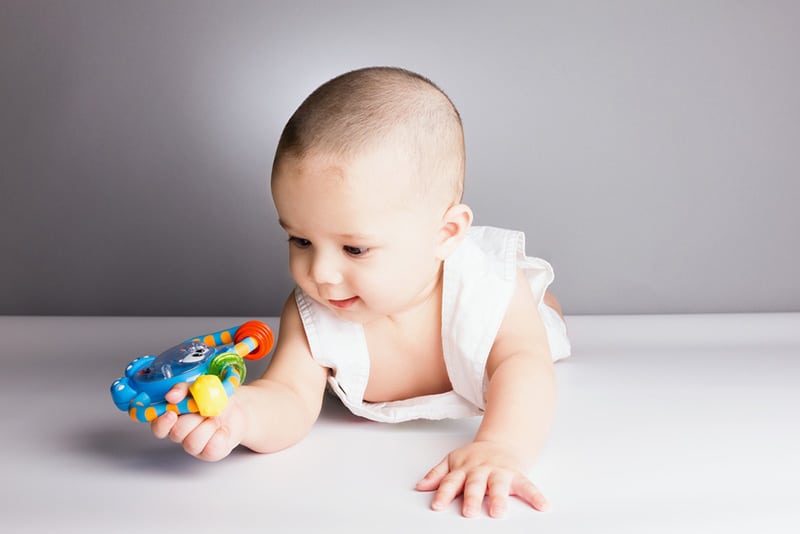
I myself am not a baby, (even though my mother still thinks I am, sorry mum) but I enjoy staring at contrasting things and specific colors like babies do.
Matching colors are one of my favorite things in the world because you have the ability to be creative with colors and express yourself.
But, enough about me. What I’m trying to say, or write, is that both adults and babies like contrasting things and colors, but we just don’t pay as much attention to them. For example, when I see a fluorescent T-shirt I can’t help but stare at it, even if I don’t want to.
The same thing applies to babies. To them, everything is fluorescent. They are mesmerized by bright colors and enjoy staring at random things with interesting colors.
It could be a book, a toy, or a piece of furniture. Or even two contrasting colors, like a red pillow on a green sofa or a black table next to a white wall. Babies find these patterns more interesting and that is why they stare at them for longer than usual.
Another great example is a baby memory book. If you show your baby his or her memory book, with their pictures or some drawings in it, they will stare at images with contrasting colors and other eye-catching details for longer.
4. They are drawn to interesting and unique features

When I’m talking about babies, and how they see the world around them, I like to compare them with cats. As the owner of a fluffy feline, I’ve noticed that they have many things in common!
Both babies and cats are drawn to interesting and unique features, such as: colorful hair, eyeglasses, earrings, different textures (cats prefer fluffy and soft ones), interesting facial expressions, etc.
All of these things catch their attention and provide a different experience, which is crucial when it comes to a baby’s cognitive development.
Have you ever wondered why babies stare at lights? It’s because their eyesight is still developing and lights create an interesting contrast between brightness and darkness.
Baby musical instruments and interactive books for babies are great at catching, and holding, a baby’s attention because they provide different sensory experiences (sounds, pictures, textures) and also help babies explore the world in their own unique way.
5. They learn by simply observing
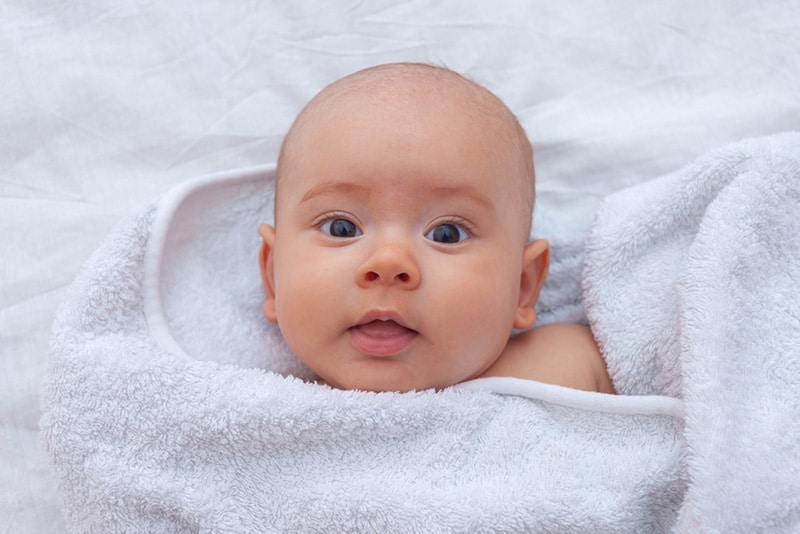
I’m sure there are those who are still asking themselves questions like: Why do babies stare at nothing and smile? or Why do babies stare at the ceiling? It isn’t necessarily because they are on the spectrum, but because they learn by simply observing things around them.
We may not think staring at nothing seems like a joyful experience, but babies see things differently.
In contrast to adults, babies eyes are ten times more sensitive to color and their ears are ten times more sensitive to sound, which is why they randomly stare while still having fun and learning.
Did you know that in the first year of a baby’s life, their brain will double in size? Yup. Babies make amazing progress every day and observation is a part of their physical and mental development.
6. Their brain is still growing and developing
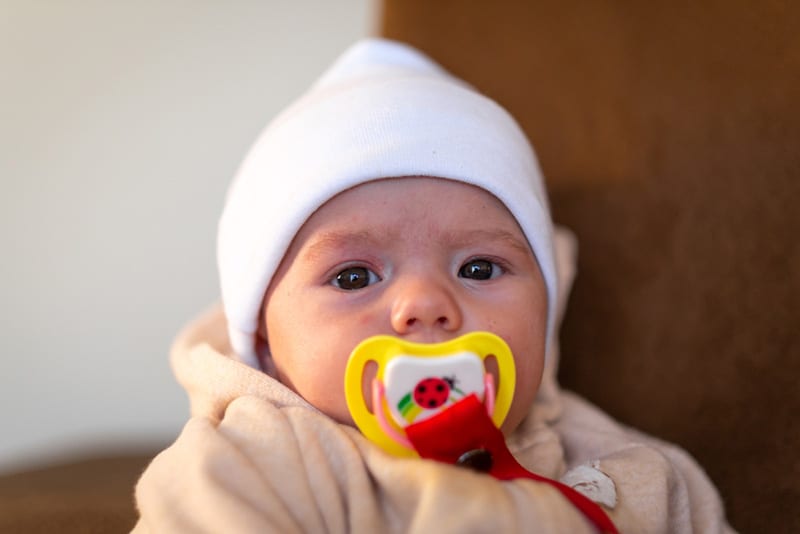
As I wrote above, the biggest reason why babies stare at random things and people is that their brain is still growing and developing. It means they are working hard to figure out how things function and why they happen in a specific order, etc.
Observation shapes their thinking and helps them develop many skills during the first years of their lives. This might sound confusing, but the truth is that babies are capable of learning a lot about things just by observing them.
If you’re looking for ways to encourage a child to explore the world, toys for fine motor skills development are every parent’s best friend.
These toys can help children learn how to write, play different sports and much more.
Best of all, is that these toys are available for kids of all ages, so all you need to do is find the right ones according to your little one.
Montessori toys for babies are an excellent choice for your baby’s development. They look super simple, but offer so much scope for exploring and learning.
4 Interesting Facts About Baby Vision
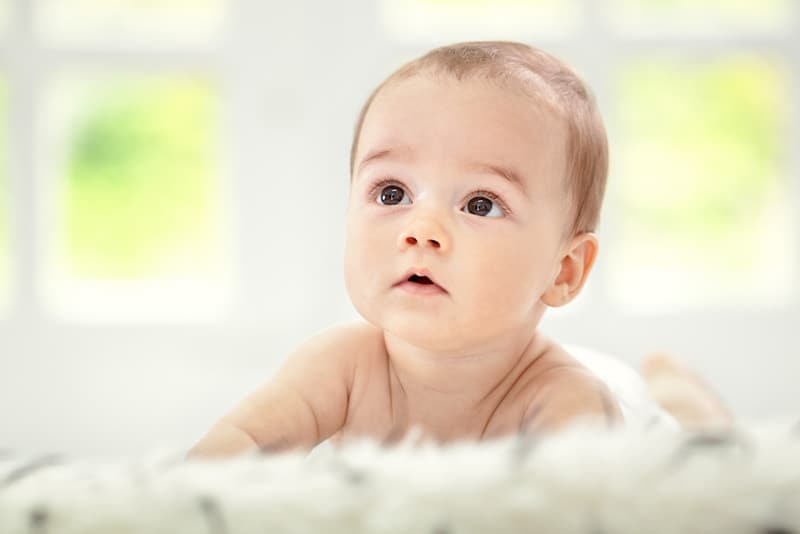
In order to understand why babies stare at random things, people, or nothing at all, we must first learn some facts about their vision.
Here are some facts about baby vision that you might not know:
• Babies are overly sensitive to light. When exposed to bright light, the baby’s pupils will constrict. Also, light helps to wake up their senses.
Giving them toys with lights will make their discovery journey exciting and fun.
• Babies have difficulty seeing far away people and objects clearly, because their central vision is still growing. Their side vision allows them to see objects that are located close to them.
• They can easily focus on things that are 8-12 inches away from them. Things that are farther than that are perceived as blurry and out of focus. This is another reason why babies sometimes ‘stare at nothing’.
• A few weeks after birth, they can differentiate between light and dark textures and patterns, and display a fondness for staring at large shapes and bright colors.
They usually prefer staring at bright objects, which is one of the reasons why baby toys are usually made in bright colors and patterns instead of dark ones.
To summarize, babies tend to stare more at humans with interesting facial features and bright colors (jewelry, glasses, etc).
They are also more attracted to contrasting patterns and colors and moving objects. Toys in bright and contrasting colors keep them engaged for longer than toys in non-contrasting or dark colors.
When Should You Start To Worry About A Baby’s Staring Habit?
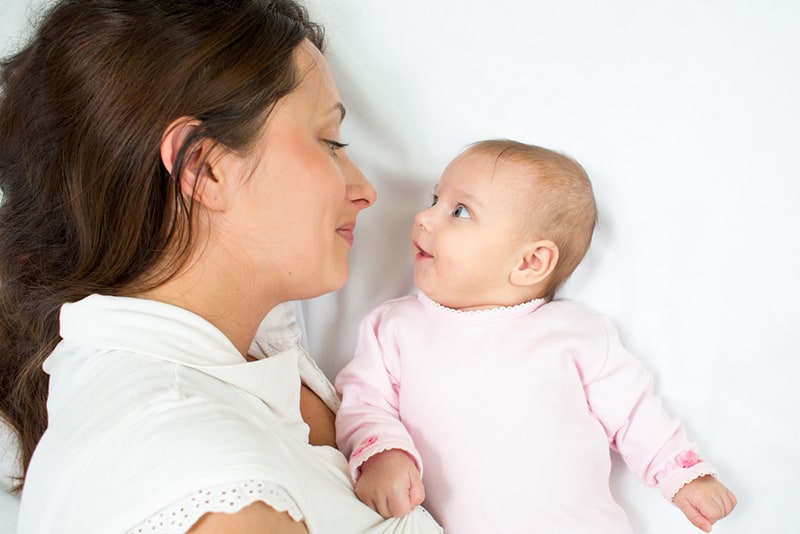
It is normal for babies to stare at random objects and people up until the age of four months. If they continue their ‘staring habit’ after that timeframe, you may want to consult with a pediatric ophthalmologist or a pediatrician.
Even if your baby is still staring at things after four months, there’s no need to panic, but it’s recommended that you consult with a professional just to be on the safe side.
Here are some other signs you should pay attention to if you notice that your baby is displaying them:
• Baby’s eyes look crossed or wander aimlessly and randomly.
• Their pupils look white or they appear cloudy.
• The baby doesn’t stare at/pay attention to/notice/is not interested in human faces by 2 months of age.
• The baby doesn’t follow moving objects by 4 months of age.
Parents shouldn’t be concerned with their newborns and babies (below 4 months of age) staring at random objects and people, because this is a natural part of the developmental process.
If you have a baby who is at the ‘staring at things’ stage, you can help them with their development process by giving them toys with contrasting colors, bright toys and introducing him or her to different textures and patterns.
Final Thoughts
I hope that the answer to the question, Why do babies stare? is no longer a mystery to you, and that you now better understand the unique way in which babies perceive the world and things around them.
As your baby grows older and his or her cognitive functions improve, you will notice that they stare aimlessly less and less, but engage in meaningful gazing, begin to recognize things, and react accordingly.
Over time, they will learn to use their senses to exchange information, absorb information, and collect valuable intel about everything they see around them.
Babies are truly amazing creatures.
References:
• Jacob, B. (2018, December 24). Women Working. “Study Reveals That If Babies Stare at You, It’s Because You’re Beautiful”.
Like this post? Please share or pin it for later. You can also stay in the loop and follow us on Facebook, Instagram and Pinterest.
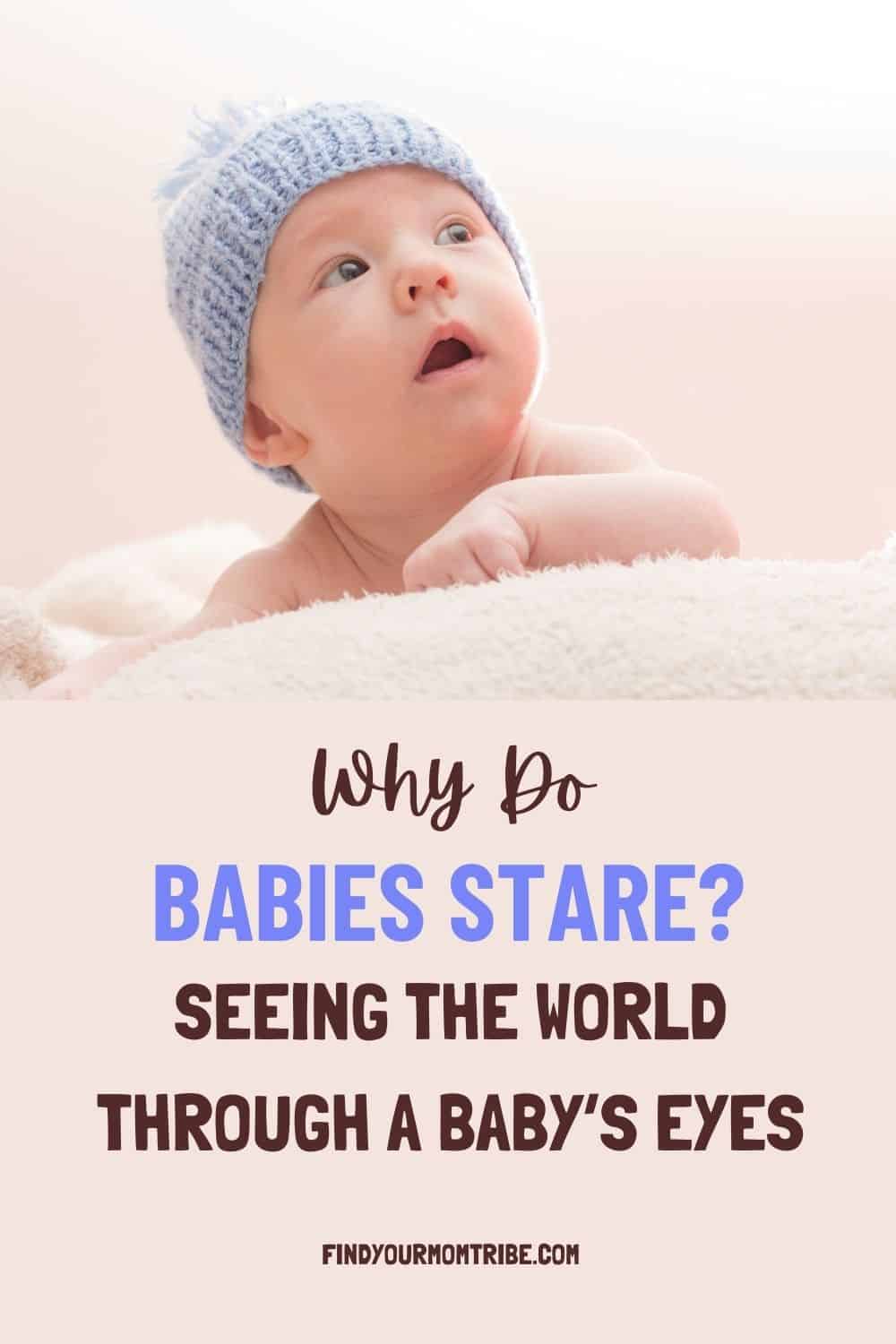
This post contains affiliate links. Please see our full disclosure for more info.

